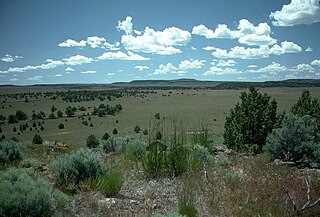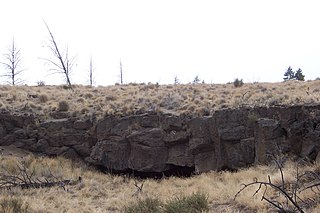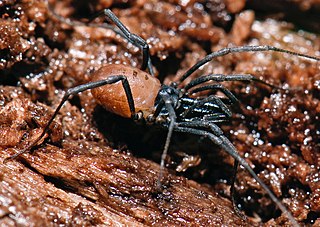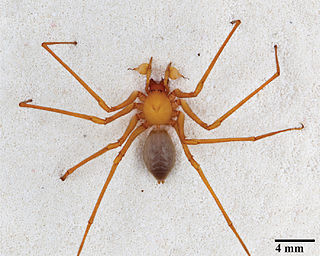
The Opiliones are an order of arachnids colloquially known as harvestmen, harvesters, harvest spiders, or daddy longlegs. As of April 2017, over 6,650 species of harvestmen have been discovered worldwide, although the total number of extant species may exceed 10,000. The order Opiliones includes five suborders: Cyphophthalmi, Eupnoi, Dyspnoi, Laniatores, and Tetrophthalmi, which were named in 2014.

Lava Beds National Monument is located in northeastern California, in Siskiyou and Modoc counties. The monument lies on the northeastern flank of Medicine Lake Volcano and has the largest total area covered by a volcano in the Cascade Range.

Dyspnoi is a suborder of harvestmen, currently comprising 43 extant genera and 356 extant species, although more species are expected to be described in the future. The eight families are currently grouped into three superfamilies: the Acropsopilionoidea, Ischyropsalidioidea, and Troguloidea.
Banksula melones is a species of harvestman in family Phalangodidae. It is endemic to caves along the Stanislaus River of California, United States.

Troglosironidae is a family of harvestmen with seventeen described species in a single genus, Troglosiro, which is found on the island of New Caledonia, in the Pacific Ocean.

Ogoveidae is a family of harvestmen with three described species in one genus, Ogovea, which is found in equatorial West Africa.

Nipponopsalididae is a family of harvestmen with three described species in one genus, Nipponopsalis, which is found in East Asia.

The Oregon high desert is a region of the U.S. state of Oregon located east of the Cascade Range and south of the Blue Mountains, in the central and eastern parts of the state. Divided into a southern region and a northern region, the desert covers most of five Oregon counties and averages 4,000 feet (1,200 m) above sea level. The southwest region is part of the Great Basin and the southeast is the lower Owyhee River watershed. The northern region is part of the Columbia Plateau, where higher levels of rainfall allow the largest industry on private land to be the cultivation of alfalfa and hay. Public land within the region is owned primarily by the Bureau of Land Management, which manages more than 30,000 square miles (78,000 km2) including five rivers designated as Wild and Scenic.

The Lava River Cave near Bend, Oregon, is part of the Newberry National Volcanic Monument, which is managed by the United States Forest Service. At 5,211 feet (1,588 m) in length, the northwest section of the cave is the longest continuous lava tube in Oregon. While the cave's discovery in 1889 was officially credited to a pioneer hunter, the presence of obsidian flakes near the cave has led archaeologists to conclude that Native Americans knew about the cave long before settlers arrived in central Oregon.

The Horse Lava Tube System is a series of lava tubes within Deschutes County, Oregon, of the United States. The system starts within the Deschutes National Forest on the northern flank of Newberry Volcano and heads north into and near the city of Bend. The system continues north to Redmond and includes the Redmond Caves. The flow diverts into the Redmond Dry Canyon, where the last known segment is known to exist; however, the basalt flow that created the system goes beyond to Crooked River Ranch and terminates just short of the Crooked River Gorge. The lava flow that created the Horse system is also referred to as the Horse Cave lobe and it filled the ancient channel of the Deschutes River which at that time flowed around the east side of Pilot Butte. The Horse Cave lobe is a part of the basalt of Lava Top Butte which also consists of the Arnold Lava Tube System, the Badlands rootless shield, and the Lava Top butte basalt. All have a geologic age around 80,000 years old.

The Arnold Lava Tube System is series of lava tubes in Deschutes County, Oregon, in the United States. It is located several miles southeast of the city of Bend. The system starts in the Deschutes National Forest on the northern flank of Newberry Volcano, heads northeast onto BLM land before finally terminating on private property near Horse Ridge. The system acted as a conduit for the lavas from Lava Top Butte that later fed the Badlands rootless shield. The lava flow that created the Arnold system is also referred to as the basalt of Lava Top Butte and is related to the Horse Cave lobe which is a lava flow that created the Horse Lava Tube System. The lava flows of Lava Top Butte, the Badlands, the Horse system, and the Arnold system all have a geologic age around 80,000 years old.

In volcanology, a pressure ridge or a tumulus, and rarely referred to as a schollendome, is sometimes created in an active lava flow. Formation occurs when the outer edges and surfaces of the lava flow begin to harden. If the advancing lava underneath becomes restricted it may push up on the hardened crust, tilting it outward. Inflation also takes place and is a process where the plastic layer of lava underneath expands as it cools and small crystals form. The end result is a raised mound of hardened lava rock, usually a relatively narrow but long ridge. Tension cracks form on the surface of pressure ridges and run along the axis of elongated ridges, and at both edges of broader ridges, sometimes referred to as pressure plateaus. Along the edges of a pressure ridge, if the tension crack is large enough it will create a liftup cave. Other caves can form inside pressure ridges in which conditions arose for the ridge to form and but the lava that created the internal pressure quickly drained leaving an inflationary cave.

The Oregon High Desert Grotto is an American caving club, known as a Grotto. It is affiliated with the National Speleological Society.

The Redmond Caves are a group of six lava tubes in Deschutes County, Oregon, United States. The caves are located in the city of Redmond and are jointly managed by the city and the Bureau of Land Management (BLM). Five of the caves are in the Redmond Caves Park and have been known locally for over 100 years. The caves are part of the Horse Lava Tube System and the farthest northern extent of the system. The lava flow that created both the Horse system and the Redmond Caves continued into the Redmond Dry Canyon and terminated near Crooked River Ranch. The caves have a geologic age of about 80,000 years.

Taracus is a genus of harvestman, or Opiliones, typically found living in limestone and lava caves in the United States. They grow to a size of 2.0–5.5 mm (0.08–0.22 in).

Trogloraptor is a genus of large spiders found in the caves of southwestern Oregon. It is the sole genus in the family Trogloraptoridae, and includes only one species, Trogloraptor marchingtoni. These spiders are predominantly yellow-brown in color with a maximum leg span of 3 in (7.6 cm). They are remarkable for having hook-like claws on the raptorial last segments of their legs.

Derrick Cave is a lava tube located in the remote northwest corner of Lake County, Oregon. The cave is approximately 1,200 feet (370 m) long. It is up to 80 feet (24 m) wide and 46 feet (14 m) high in places. It was named in honor of H.E. Derrick, a pioneer rancher with a homestead 3 miles (4.8 km) southeast of the cave. The land around the cave is managed by the United States Department of Interior, Bureau of Land Management. Derrick Cave is open to the public year-round; however, camping is no longer permitted in the cave.

Taracidae is a family of harvestmen in the order Opiliones. There are 4 genera and 23 described species in Taracidae.

Plumatyla humerosa is a millipede species found in mines, as well as lava tube and limestone caves of northern California and south-central Oregon. It belongs to the family Conotylidae. The millipede is likely a troglophile with a white carapace and observed in lava caves though it may inhabit crevices as well. P. humerosa is observed frequenting areas with mold or bat feces on the cave floors. Taracus marchingtoni has been observed feeding on P. humerosa within cave habitat.

Forsteropsalis photophaga, also known as the glow-worm hunter, is a species of long-legged harvestman in the family Neopilionidae. This species is endemic to New Zealand, found in North Island caves in the vicinity of Waitomo. The name "photophaga" comes from their habit of feeding on the luminescent larvae, pupae, and adults of the New Zealand glow-worm Arachnocampa luminosa.



















